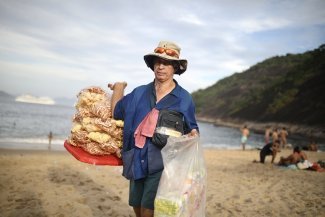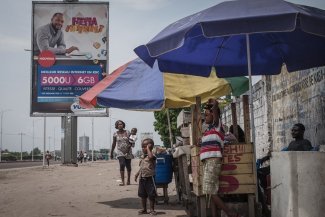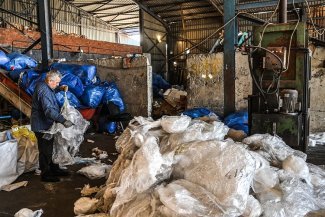An Indonesian worker in the fishing sector.
It’s an unpalatable truth but for all our technological advances, for all our rights enshrined by international law, the majority world remains crushed underfoot by the wheels of global capital. This exploitation is racialised as it is gendered. Children in Asia make our clothes; Black and Brown women working in fields, factories and private homes endure untold violence and abuse; Indigenous people are evicted from their ancestral land by big business backed by governments, or killed and harassed for their resistance; and economic migrants from the ‘wrong countries’ are trafficked and criminalised, forced to choose between insurmountable poverty at home, or a life of debt bondage, wage theft and other forms of exploitation and discrimination abroad.
According to the International Labour Organization, 40.3 million people are victims of modern slavery globally, while 24.9 million people are affected by forced labour. This Monday marked the World Day Against Trafficking in Persons, of which 71 per cent of victims are women and girls. These horrifying statistics demonstrate the scale of the problem but what they don’t highlight is the scale of the effort being made to stop the extreme exploitation of workers, as this fourth edition of our themed summer series hopes to prove.
In the Middle East, for example, where tens of thousands of migrant women from Asia and Africa work in the care industry, primarily as domestic workers, the kafala “sponsorship system” continues to drive economic growth while leaving workers vulnerable to abuse. The persistent efforts of trade unions and civil society have resulted in significant reforms for migrant workers in Qatar for example, but in Lebanon, where Florence Massena tells the story of the Ethiopian domestic worker who jumped from a second-floor apartment to escape the abuse of her violent, fashion designer boss, local activists are limited in their ability to protect domestic workers, due to their exclusion from the country’s labour laws.
Globally, an estimated 152 million children between the ages of 5 and 17 are victims of child labour, and almost half work in hazardous conditions. Approximately 62.1 million child labourers can be found in the Asia-Pacific region, and as Laura Villadiego reports from Indonesia, the country is seriously behind on its pledge to eradicate child labour by 2022. In Indonesia’s case, while the laws to protect children from labour exploitation exist, enforcement is a major issue.
Although multinationals are beginning to take increasing responsibility for ending modern slavery in their supply chains, exploitation is rife in global agriculture, and the plight of palm oil plantation workers in Guatemala highlighted in Nazaret Castro’s story embodies many of the issues faced by local communities in the Global South.
Not only does agribusiness bring polluted rivers, deforestation and the dangerous impacts of agrichemicals, but workers also face “working conditions reminiscent of the days of slavery.” As one farmer told Equal Times: “[Cultivators] work long hours for little money, with no fixed working hours, and they have to buy their equipment themselves. But there is nothing else. If there were another source of income, they wouldn’t do this, but we have to eat.”
In Europe, migrant workers are amongst the most exploited and criminalised, and nowhere is this more apparent than in sex work, where scores of women and children are victims of trafficking. Even those who ‘choose’ to sell sex usually do so because there are no other options open to them. But that’s not how the law treats them. As one sex worker told journalist Linda A. Thompson: “All these laws that they create that are supposed to protect women. All they do is increase violence against us. They leave us without tools to defend ourselves.”
Mauritania has been described by CNN as “slavery’s last stronghold”. It is one of the few remaining countries where, according to Anti-Slavery International, “people [of Afro-Mauritanian or Haratine origin] are still born into slavery and literally owned by other people, facing a lifetime of abuse and forced labour.” Last summer, Equal Times published Bryan Carter’s in-depth documentary on the appalling conditions of slavery that force an estimated 20 per cent of the population to work on farms and in homes without pay and without any possibility of freedom.
The aforementioned stories are just some of the examples of the extreme exploitation facing workers around the world today. But the solution doesn’t just lie with governments or corporations, or even with civil society and trade unions. As individual workers and as conscious consumers, we have to play our part to ensure its eradication.
Abused Ethiopian domestic worker is “the poster girl for kafala” in Lebanon
By Florence Massena
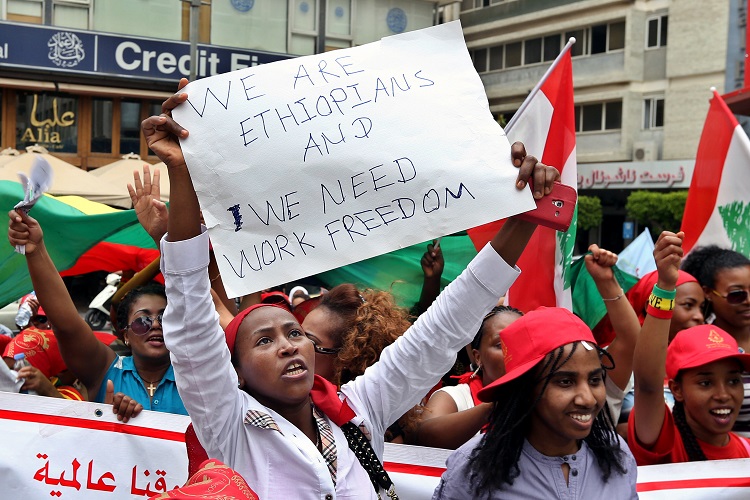
A migrant domestic worker from Ethiopia holds a placard during a march demanding basic labour rights in Beirut, Lebanon, on 3 May 2015. There are more than 250,000 migrant domestic workers in Lebanon, mostly women from Asia and Africa, and the recent case of Lensa Lelisa has highlighted the terrible abuse that many of them face.
No matter how many times one hears about the abuse and exploitation of migrant domestic workers in the Middle East, the stories do not become any less shocking, as the harrowing case of Lensa Lelisa proves. This March, the 21-year-old Ethiopian domestic worker working in Beirut, Lebanon, made headlines after she jumped from a second-floor balcony at her employer’s house – the Lebanese fashion designer Eleanore Ajami. She was attempting to escape the violent abuse that she says that she and another Ethiopian colleague endured at the hands of Ajami and her three adult children: Alexis, Crystel and Joe Khalil.
Lensa broke both her legs in the incident and injured her face. In a video recorded from her hospital bed by This is Lebanon, a group that shares stories of domestic worker abuses in the country, Lensa describes how “from the very beginning they were abusing me”. In the video she says: “They tortured me and I couldn’t do anything to save myself. They beat me every day with an electric cable and wrapped my hair around their hands and dragged me around the room. They smashed my head into the walls.”
Read the full article on Equal Times
Slow progress in the fight against child labour in Indonesia
By Laura Villadiego
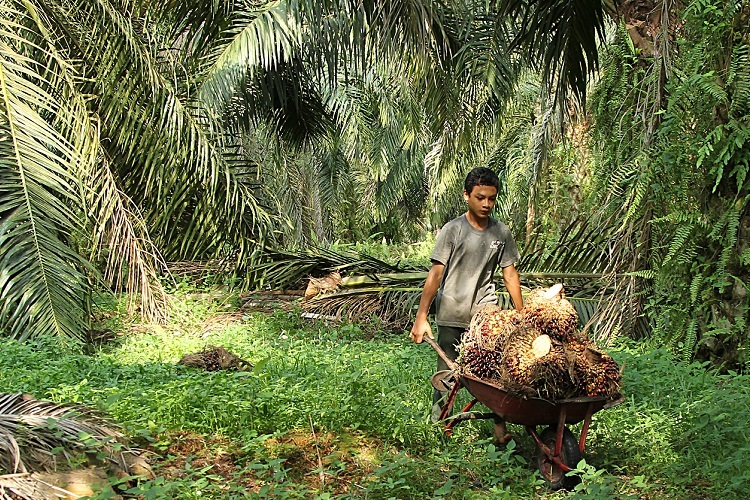
A 13-year-old working on an oil palm plantation on the island of Sumatra, Indonesia.
On 26 October, Putri and Surna went, as they did every day, to the fireworks factory where they worked in Tangerang, on the outskirts of Jakarta, the capital of Indonesia. That day, however, was not any ordinary day. A spark came into contact with the gunpowder stored at the factory, triggering an explosion that killed 47 workers, including Putri and Surna. Their case was special: Putri was 14 years old and Surna 15, and their work at the factory was illegal.
Their case is not, however, an isolated one. Despite the roadmap published by the Indonesian government in 2015 to eradicate child labour by 2022, the presence of minors in the country’s factories and plantations continues to be an everyday reality, with just four years to go to the deadline.
According to the latest report of the United States Department of Labor, although Indonesia made a “moderate advancement” in the efforts to eliminate the worst forms of child labour in 2016, with the formation, for example, of local anti-trafficking task forces in the various provinces, or community-based monitoring inspectors to report incidences of child labour, minors are still performing hazardous tasks on oil palm and tobacco plantations, and are also present in the sex industry.
Read the full article on Equal Times
Ecocide and modern slavery in the land of the Maya: the impact of oil palm cultivation in Guatemala
By Nazaret Castro
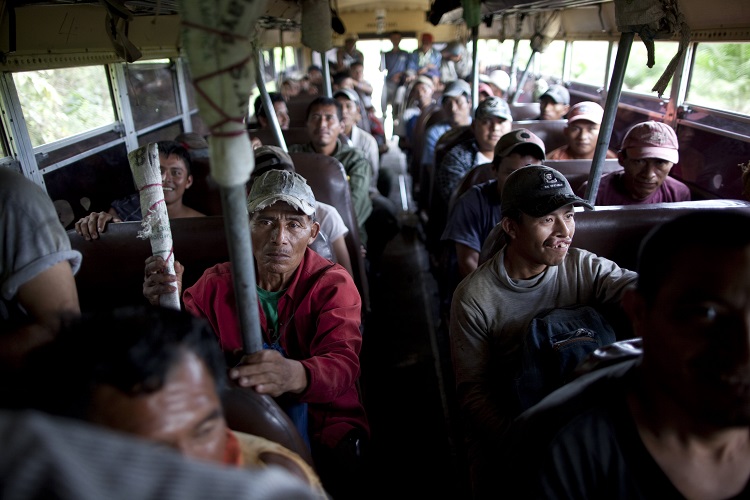
In this photo from 2012, oil palm workers are taken back to their villages after a day’s work on the plantations of Sayaxché, Guatemala.
It looks clean and exuberantly beautiful, but the lake is contaminated. And the lives of 700 people depend on this lake, all residents of the Manos Unidas (United Hands) Cooperative, a community that is part of the municipality of Sayaxché, in the Petén department, northern Guatemala.
Manos Unidas has become the last frontier of resistance to the advance of palm oil production in the region, as the only community that has hung on to its land; and that, say its residents, is because the lands are common property.
The collective ownership of the land complicates the strategies of the palm oil companies which forced the farmers in neighbouring communities to sell, using veiled threats and obscure arguments according to the three communities visited for this report. For this reason, and thanks to the tenacity and political awareness of these people, Manos Unidas still owns land for cultivating sweet corn and beans, and for renting out to families from neighbouring communities.
Read the full article on Equal Times
“Don’t criminalise us, protect us,” say Europe’s migrant sex workers
By Linda A. Thompson
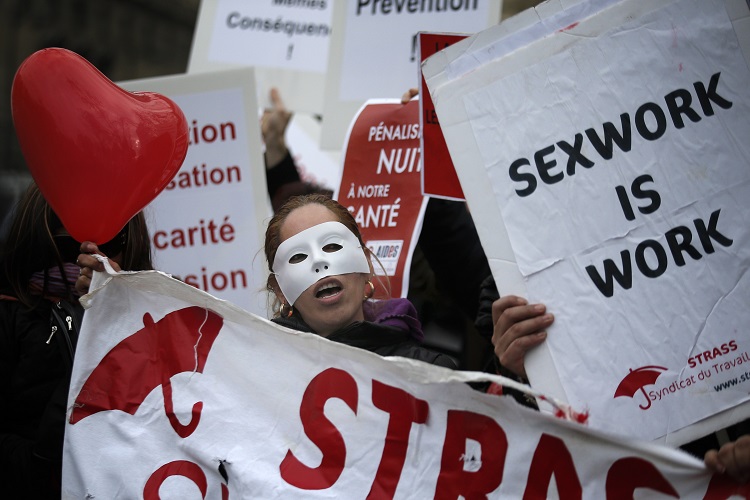
The majority of sex workers in Europe today are migrants, refugees and asylum seekers.
When reports surfaced in 2014 that asylum-seekers in Ireland had started selling sex because they were unable to survive on the cash allowances given by reception centres, the country’s Minister of Justice, Frances Fitzgerald, was quick to order an investigation into the allegations and told Irish radio that she was considering introducing a law that would criminalise the buying of sex.
Noting that asylum-seekers staying in reception centres were given just €20 a week at the time, Luca Stevenson, coordinator of the International Committee for the Rights of Sex workers in Europe (ICRSE), says that Fitzgerald’s response ignored the structural conditions that push women to start selling their bodies in the first place.
Rather than prosecuting those who paid the women to perform sexual services, he said: “You need to give more money to asylum-seekers, migrants and refugees so that they don’t have to sell sex in the first place.”
Read the full article on Equal Times
Mauritania is failing to eradicate slavery and forced labour
By Bryan Carter
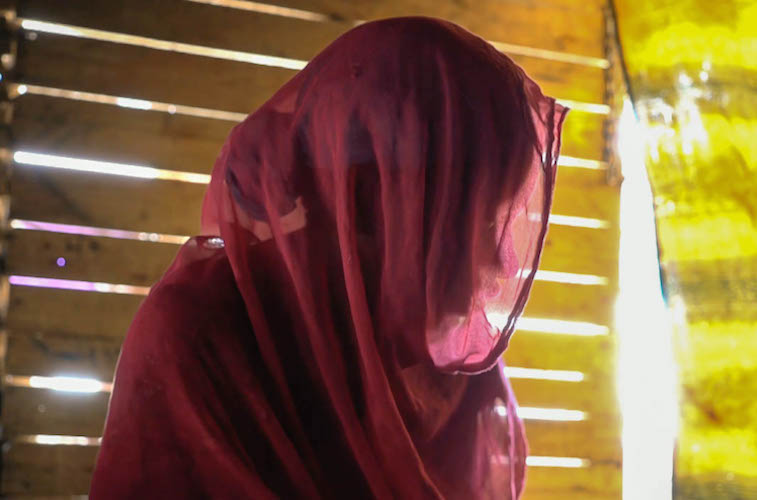
Mauritania became the last country in the world to outlaw slavery, but despite government promises to enforce abolition, Mauritania still has one of the largest populations of enslaved people on earth.
“Our freedom, our dignity, will never be truly and fully achieved until there are no more slaves in this country.”
Taken out of context, these words seem to have come straight out of the darkest chapters of human history. They weren’t spoken in the 19th century, but just a few weeks ago, by Boubacar Mesaoud, a well-known human rights activist in Mauritania who has been fighting for decades to put an end to the scourge of slavery that continues to ravage his country.
Estimates of the number of slaves in Mauritania range from between 1.06 per cent and 20 per cent of the population of about a quarter of a million inhabitants, but it is almost impossible to say just how many there are because it is a multi-faceted phenomenon, rooted in Mauritanian society. Slavery in this desert land, bigger than France and the United Kingdom put together, persists almost exclusively within the black “haratine” community which, despite being the majority population group, lives under the yoke of the “Moorish” Arab-Berber minority who control all the levers of power; economic, political, religious and military.








